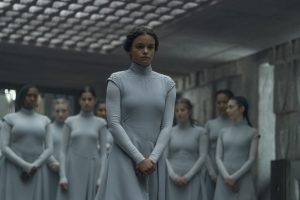In the canon of great television intros, few hit harder than the opening number of Nickelodeon’s Avatar: The Last Airbender.
Each episode of the animated series begins with a brief rundown of the show’s setting and concept, as recited by the character Katara (voiced by Mae Whitman). In just under a minute, Katara gets viewers up to date with everything they need to know to enjoy the proceedings, saying:
“Water. Earth. Fire. Air. Long ago, the four nations lived together in harmony. Then, everything changed when the Fire Nation attacked. Only the Avatar, master of all four elements, could stop them. But when the world needed him most, he vanished. A hundred years passed and my brother and I discovered the new Avatar – an Airbender named Aang. And although his airbending skills are great he has a lot to learn before he’s ready to save anyone. But I believe Aang can save the world.“
Simple. Descriptive. Iconic. Many Avatar: The Last Airbender fans can recite the passage by heart (even the wordier one that precedes the pilot). It’s the rare TV intro to receive both its own meme and Genius entry.
When Netflix announced that it would be adapting Avatar: The Last Airbender into a live-action remake, one of the obvious questions facing it was whether it would preserve that beloved opening. Now we know the answer to that is … sort of.
Since Netflix encourages binge-watching by releasing every episode of its series at once, there isn’t much of a need for a refresher before each episode. And even if there were, the streamer would probably give you the option to skip it with the vile “Skip Intro” button. Thankfully, however, the first episode of Netflix’s Avatar does feature something akin to the cartoon’s opening explainer. Roughly five minutes into episode 1 “Aang” the show launches into an extended title sequence that fulfills many of the expository needs of the animation’s intro.
The full text from the intro reads:
“Water. Earth. Fire. Air. For millennia the four nations have lived in harmony. A peace made possible by the Avatar – the one person with the ability to master all four elements and protect the delicate balance between nations. When one Avatar dies, their spirit is reborn into a new body in an eternal cycle. Since the death of the last Avatar, the new incarnation has yet to emerge. And so Fire Lord Sozin, the ruthless leader of the Fire Nation believes this is his moment to launch a merciless campaign to conquer the world. His first step is to eliminate the one person who can stand in his way: the next master of all four elements, an Airbender who may not be ready for the responsibility of becoming the Avatar.”
There are some notable differences from the original here. For starters, Katara is not the narrator but the former Avatar Kyoshi per Netflix’s closed captions. While Kyoshi is great (and played quite effectively later on in the series by Yvonne Chapman) opting for a more objective observer of the story rather than the highly-involved Katara robs the narration of some warmth. Additionally, the imagery presented here, while visually impressive, is also cold. A smiling Aang rolling around on his conjured bouncy cloud is sorely missed.
The biggest issue with the new Avatar: The Last Airbender intro though is that it appears only once. Netflix is probably correct in assuming that many of its viewers are watching the series as a binge. But that’s no reason to rob them of a little treat to begin each installment. The original Avatar: The Last Airbender‘s opening isn’t remembered solely because of its creativity, it’s remembered because of its relentless repetition. Whether watching weekly or breezing through three seasons worth of episodes at once, Avatar fans got to experience the show’s introduction over and over and over again.
Rather than becoming bored with that intro, fans became increasingly enchanted with it. “Repetition” can be viewed as a dirty concept in the streaming world where television series increasingly resemble long movies arbitrarily chopped up into parts. That mindset misunderstands just how great repetition can be! Bring on the intro every time. Let is serve as a palate cleanser and reset button after another chapter in Aang’s increasingly dark story.
Lengthy diatribe against the insidious nature of streaming television aside, this new intro does improve upon the original in one meaningful way. Those paying close attention will see that the scene includes rare, vibrant looks at the many Avatars before Aang, with at least five being identifiable. ScreenRant first reported the full list here, with the recognizable Avatars being, in reverse chronological order: Avatar Roku, Avatar Kyoshi, Avatar Kuruk, Avatar Yangchen, and Avatar Szeto. Kyoshi’s narration mentions the concept of the Avatar cycle of rebirth and having a visual accompaniment helps it all hit so much harder.
Now if only we got to see that all play out multiple more times while watching the series.
All eight episodes of Avatar: The Last Airbender are available to stream on Netflix now.
The post Netflix’s Avatar: The Last Airbender Intro Is a Major Downgrade (With One Exception) appeared first on Den of Geek.






